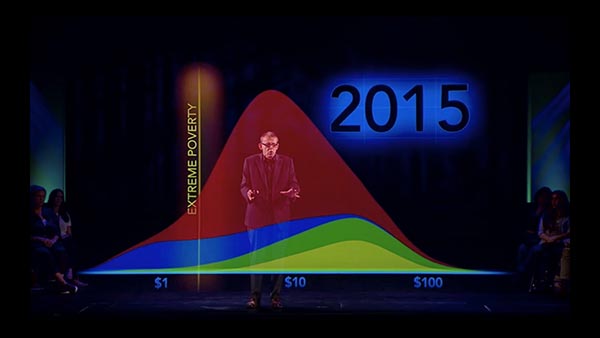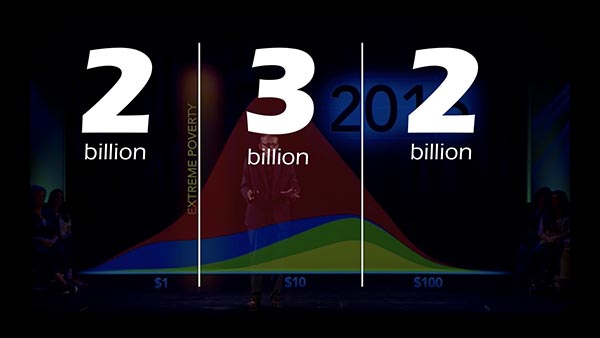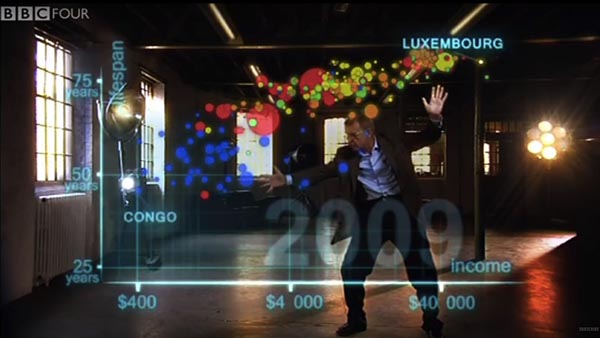
Hans Rosling has a great new talk on global poverty (with even better graphics than his first TED talks). As always, he tells a great story. However, in his five minutes he explains what happened over 215 years, but doesn’t provide any analysis. Most importantly, he doesn’t point out that we are not only winning this war on global poverty, but at the same time losing.
The story starts in 1800, when just about everyone in North America (yellow), Europe (green), Africa (blue), and Asia (red) were equally impoverished. The story ends in 2015 with most of the world living out of poverty.
1800 is an arbitrary starting point. The graph for 1500 or 1000 or even 2000 BC would have looked similar, albeit with less people in total. The reason so many people were poor in 1800 is simple, 95% of everyone was a farmer.
The economics of farming are horrible when everyone is a farmer. When a farmer grows food that is eaten by his (and her) family, no money changes hands. Thus no income is generated. Poor people by definition have little to no income. To make money as a farmer, you need a lot of people who are not farmers. People who have to buy the food they eat. Today, 99% of Americans and Europeans are not farmers.
The question then is how did we get from a world of 95% farmers to 1% farmers? Simple answer, the Industrial Revolution. Not a revolution of guns, but a revolution of a key idea: moving beyond human and horse power, to harnessing the power of machines.
For example, in 1800 a plow would have been pulled by one horse (or an ox), i.e. a “one horse-powered plow”. That was replaced by a 100 horsepower tractor, pulling multiple plows, burning oil for power.
In 1800, it would have been common to see two horses pulling a cart. By 1850 it was not uncommon to see a 20,000 horsepower steam locomotive, pulling a whole train of cars, burning coal for power.
There were some machines in 1800. Flour wasn’t made by hand, it was ground at the mill. That would be a water wheel powered mill if there was a stream or river nearby, with that water wheel generating a 1 kilowatt of power. Today you can have a kilowatt of power from one electrical outlet, which gets its power from one of thousands of electric generation stations, each of which generates a gigawatt (a billion watts) of electricity, burning coal or natural gas.

The key formula for the Industrial Revolution is to (a) turn energy into industry, which (b) creates jobs, and (c) jobs create wealth. For 200 years that energy has primarily been fossil fuels, dug or pumped from the ground.
More specifically, this process has been driving the growth in America and Europe for 200 years, with India and China following suit over the last 50 years. That time lag explains why America and Europe were richer in the 19th and 20th Centuries, and why it seems India and China are quickly catching up.
This gives us the modern world, where 2 billion people live better and longer lives than the kings in 1800. Where 3 billion people in “the middle” aspire to live like the top 2 billion, and whose children or grandchildren likely will. And where 2 billion people are left behind the poverty line.
Here’s where I wish Hans has stopped and pointed out the first of three flaws in the story, as it’s this breakdown of top/middle/bottom where the UN has been touting success in the war on poverty. Yes, a far greater percentage of the population is living out of poverty now than in 1800. But at the same time, there were only 1 billion people total in 1800, and today twice as many people are poor.
We’re thus winning and losing, both at the same time!
 To understand why, we need to look at the data by country. For that, we can look at the UN’s statistics for its 194 member countries, by per-capita GDP. The image along the right side is from Wikipedia (June 2016).
To understand why, we need to look at the data by country. For that, we can look at the UN’s statistics for its 194 member countries, by per-capita GDP. The image along the right side is from Wikipedia (June 2016).
Compare #12, The United States at $54,000 to #86, China at $7,200. China is halfway down the list, but the average income in China is not half the average in the U.S., it’s only 1/7th. Flaw #2 is that these Hans’ graphs chart income on a logarithmic scale. This is much clearer on the above image, where the three numbers along the bottom are $400, $4,000, and $40,000. The rich are 7 times richer than the middle, who as we’ll see in a moment, are more than 7 times richer than the poor.
Flaw #3 is more troublesome. Scroll down to #161, Cambodia. It’s average income is $1,100. If you earn $3 per day, for each of the 365 days of the year, you’d earn a total of $1,100. To my American eyes, that person is poor. So is the average Ugandan living in country #176, who earns an average of $2 per day (365 x $2 = $730). None the less, according to the UN, these people are in the middle, as the “Extreme Poverty” live is at $1.90 per day. This was heralded as big news in 2015, as previously it had been set at $1 per day.
The good news in this story is that billions of people are no longer poor. The bad news is that we’ve left billions behind.
That said, we do know why they’ve been left behind. Look at the bottom third of countries on the list, and you’ll see a list of countries where 85% or more of the population are farmers. Sound familiar? It sounds crazy, but the underlying truth hiding in this data is that the Industrial Revolution has yet to reach a third of the people on the planet. Bring those farmers machine power, and their children and grandchildren will no longer be poor. This worked for America and Europe and Japan. It worked again for China and India. And it will work for Africa, Southeast Asia, Central America, and everywhere else that has so far been left out of the revolution.



















Hi Luni,
I appreciate that you start off by defining poverty as a lack of income, because it reminds me of the efforts to replace GDP as a measure of success with something more like a GPI (Genuine Progress Indicator). I wonder how the life of a farmer compares then? http://www.demos.org/publication/whats-missing-gdp
I hadn’t seen GPI before. It looks like a better measure than GDP, but far more complicated to measure. Neither would count a substance farm feeding its family, as no cash changes hands nor any commercial-scale extraction of natural resources.